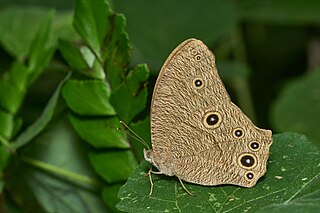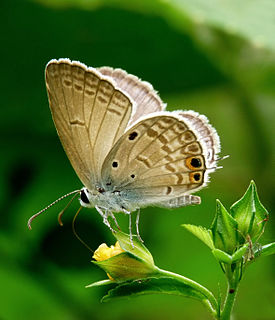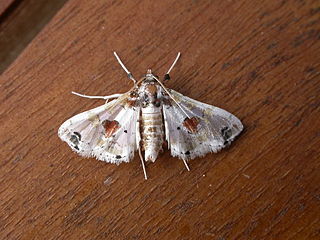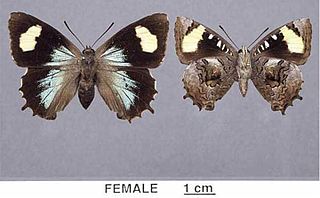
Eurema hecabe, the common grass yellow, is a small pierid butterfly species found in Asia, Africa and Australia. They are found flying close to the ground and are found in open grass and scrub habitats. It is simply known as "the grass yellow" in parts of its range; the general term otherwise refers to the entire genus Eurema.

Zizula hylax, the Gaika blue or tiny grass blue is a species of blue butterfly.

Melanitis leda, the common evening brown, is a common species of butterfly found flying at dusk. The flight of this species is erratic. They are found in Africa, South Asia and South-east Asia extending to parts of Australia.

Euchrysops cnejus, the gram blue, is a small butterfly found in India that belongs to the lycaenids or blues family found in India to Australia.

Lampides boeticus, the pea blue, or long-tailed blue, is a small butterfly that belongs to the lycaenids or gossamer-winged family.

Hypolimnas misippus, the Danaid eggfly, mimic, or diadem, is a widespread species of nymphalid butterfly. It is well known for polymorphism and mimicry. Males are blackish with distinctive white spots that are fringed in blue. Females are in multiple forms that include male-like forms while others closely resemble the toxic butterflies Danaus chrysippus and Danaus plexippus. They are found across Africa, Asia, and Australia. In the new world they are found in the West Indies, with strays in Central and North America.

The Blastobasidae are a family of moths in the superfamily Gelechioidea. Its species can be found almost anywhere in the world, though in some places they are not native but introduced by humans. In some arrangements, these moths are included in the case-bearer family (Coleophoridae) as subfamily Blastobasinae. The Symmocidae are sometimes included in the Blastobasidae as subfamily or tribe.

Hippotion celerio, the vine hawk-moth or silver-striped hawk-moth, is a moth of the family Sphingidae. It was described by Carl Linnaeus in his 1758 10th edition of Systema Naturae.
Hippotion brennus is a moth of the family Sphingidae. It is known from the Moluccas, Papua New Guinea, the Solomon Islands and north-eastern Australia.
Aureopterix sterops is a moth of the family Micropterigidae. It is known from eastern Australia, where it is known from northern Queensland, in wet coastal or elevated coastal forest between Mount Finnigan and Kirrama State Forest.

Leucinodes orbonalis, the eggplant fruit and shoot borer or brinjal fruit and shoot borer, is a moth species in the genus Leucinodes. It is found throughout the tropics in Asia and Africa and is a minor pest in the Americas. The species was first described by Achille Guenée in 1854.

Pinara metaphaea, the pinara moth, is a species of moth of the family Lasiocampidae. It was first described by Francis Walker in 1862. It is known from south-east Australia, including New South Wales and Victoria.

Elusa oenolopha is a species of moth of the Noctuidae family. It is known from Australia, including Queensland and New South Wales.

The shy cosmet moth is a moth of the Cosmopterigidae family. It is known from all of Europe, as well as Asia, Australia and New Zealand. It is also present in North America, where it is distributed from Nova Scotia to Virginia, west to Oklahoma and north to Ontario. The habitat consists of fens and marshes.

Candalides xanthospilos, the yellow-spot blue, is a species of butterfly of the family Lycaenidae. It is found in along the eastern coast of Australia, including Queensland, New South Wales and Victoria.

Candalides cyprotus, the cyprotus blue or copper pencil-blue, is a species of butterfly of the family Lycaenidae. It is found along the east coast of Australia, including South Australia, New South Wales, Western Australia and Victoria.

Ogyris genoveva, the genoveva azure or southern purple azure, is a butterfly of the family Lycaenidae. It is found in Australia.

Gesonia obeditalis is a species of moth of the family Noctuidae first described by Francis Walker in 1859. It is found from eastern Africa, the Seychelles, the Maldives and the Oriental tropics of India, Sri Lanka east to the Philippines, the Sula Islands and Australia. The adult moth has brown wings with a scalloped dark brown band near the margin. The hindwings are similar in pattern to the forewings but are a paler shade of brown.

Attacus taprobanis is a moth of family Saturniidae. It is native to southern India and Sri Lanka. This species is very similar in morphology to the much more widely distributed Attacus atlas. It was once considered a subspecies of A. atlas.
Erechthias beeblebroxi is a moth of the family Tineidae. It is endemic to Australia, where it has been recorded from Queensland.





















